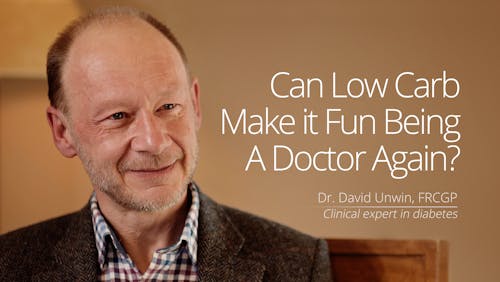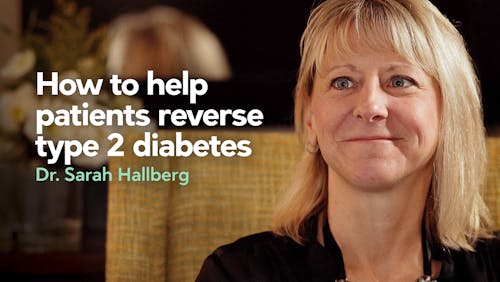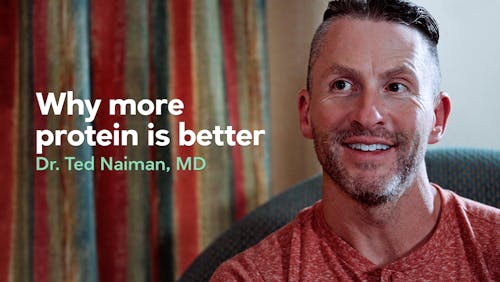Dr. Hampton: Thoughts drive success

Photo: Spencer Bibbs
Dr. Tony Hampton is a family physician on the South Side of Chicago. He is writing a monthly column for Diet Doctor. This is his eighth column.
To recap from my previous columns, the N.E.S.T acronym stands for Nutrition, Exercise, Sleep/Stress, and Trauma/Thoughts.
My columns for Diet Doctor have now discussed the other letters, and you can find those previous columns here . Now, it’s time to examine our thought processes.
When you protect your N.E.S.T. you become aware of the thoughts in your head and examine whether they are helping or harming you.
Just to be clear, I believe that nutrition — a low-carb diet — is the most critical aspect of reversing the root causes of many chronic diseases.
But to me, there’s no doubt that the second most critical aspect is how we think. This encompasses a lot of different thoughts: how we think about ourselves, our choices, our actions, our motivations, our abilities, our limitations.
Our thoughts set the stage for everything we do.
This column is going to dig a little deeper into how our thought processes can shape our health and wellness. It also discusses how certain skills and techniques can help us stop, change, or at least disarm, the thoughts that aren’t serving us.
Do your thoughts support your journey?
I always tell my patients that it’s important that they understand that their thoughts will probably be the biggest driver of their success.
I ask them to think about why they want to achieve better health. What is their goal? Are they putting themselves in the best position to be successful?
And once they know their “why,” I ask them if their thoughts are supporting their journey. Have their thoughts aligned with this vision of who they want to be and what they want to do?If you don’t do that, then your thoughts can sabotage what you are trying to achieve. So always ask yourself: Is this thought serving me or harming me?
How thoughts become habits
Pause for a minute and think about all the habits you have.
Do you want to change some habits and replace them with better habits?
Take a look at what you feel are your bad habits. What is it that you are doing? Why are you doing it? And if you examine it closely, you may see that it all starts with your thoughts.
Take, for example, treating yourself to ice cream when you are sad or perhaps coming home from work every day and pouring yourself a drink.
The thoughts in your head may be saying: I’ve had a hard day. Or I deserve this. Or I’ll feel better if I have this. Or I can’t fight this craving.Sometimes if you do the action enough times, the habit becomes so automatic that you no longer even think about the thought behind it, you just do it. But under it all is a thought, even if it is: This is what I always do in this situation.
Reprogramming your thoughts
To change the habit, you have to go back and reprogram your brain, put in a new thought, that leads to new actions and to a new habit.
Sometimes, changing the thoughts starts with getting new information, such as learning all about a low-carb diet, and thinking about how you can swap that ice cream for something low carb instead.
You can then form a new thought, such as, When I want ice cream, I will have a Diet Doctor low-carb ice cream instead. And then, you put in place the actions — such as making a recipe — that enables that change.
Reprogramming has to be done intentionally, over and over again, until it becomes a new habit you no longer even think about.
My thought litmus test
How do you know whether or not you want to change a thought you are having? I have a litmus test. I ask myself two simple questions:
- Does this thought add value to my life?
- Does this thought harm me in some way?
I try to only think thoughts that add value to my life and to not have thoughts stick around that harm me, or that lead to actions that harm me.
I think of the process of managing my thoughts like having a bouncer in my brain. He stands there and looks at all the thoughts that are trying to enter and only lets the right ones in and tosses the others out.
What thoughts harm us?
Often, it is our self-limiting thoughts that prevent us from even seeing the possibility of change. These are negative thoughts about ourselves that keep us stuck. Thoughts, like: I am not smart enough; I don’t have enough willpower; I can’t do this; I will always be fat; What’s the point? I’ll only gain the weight back.
What negative thoughts about yourself do you have in your head?
For my patients, self-limiting thoughts can be the hardest to change. That’s because they honestly believe those thoughts to be true about themselves.
7 steps to overcome self-limiting beliefs
I often have patients say to me, “Doc, it’s too hard! I can’t put that stuff behind me. How the heck am I going to change the way I have been all these years?”
I have a list of seven things to do. All of them help change the thoughts about yourself that are holding you back:
- Recognize that your thoughts matter: Whenever you are talking to yourself, I want you to pause and really listen to what you are saying about yourself. Our words become our reality. Our brains can’t really tell the difference between a real experience and one that is created by the words in our head. Remember the saying “Don’t believe everything you think?” Well first, you have to notice that you are thinking it.
- Replace the thought with a positive affirmation: When a self-limiting thought enters your head, replace it with a positive affirmation that means something to you. Have it ready. If you Google “positive affirmation,” you can find many examples, but here are few I like: “I trust myself to make the right decision.”; “I am becoming closer to my true self every day;” Or, “I am the architect of my life; I build the foundation and choose the contents.” With time and practice, it is a skill you can master.
- Make time for things that make you happy: I am not talking about hedonistic things, but things that fill your cup, that make you feel good about life. That can be a hobby where you lose track of time, a get-together with friends, or even something like listening to music that uplifts you. It is hard to have negative or worrying thoughts when you are occupied doing things that make you feel good. So make time for the fun stuff.
- Stop overthinking: Do you automatically jump to the worst possible conclusion or project into the future the worst possible outcome? Overthinking can cause emotional distress when the thought is not valid at all. Mark Twain supposedly said: “My life has been full of problems, most of which never happened.” How often are you thinking the worst? I want you to pause and let the dust settle to find out if it’s true before acting on any thought.
- Be careful who you spend time with: The company you keep says a lot about you. And sometimes that company can be feeding and reinforcing the self-limiting thoughts you have about yourself. For example, if you have someone in your life who makes you feel you can’t succeed on a low-carb diet, or who is actively sabotaging your choices, you might need to limit your time with them.
If you struggle to resist temptation, don’t surround yourself with people who tell you, “It’s okay, just have it.” Studies show seeking out the company of people with a high degree of self-discipline will boost your willpower. Aim to surround yourself with positive, affirming people who align with your goals.
- Don’t make assumptions: An assuming mindset believes things to be true without proof. Is your self-limiting thought an assumption about yourself that you have never tested? “I can’t do that” is an assumption if you have never tried it. Sometimes, assumptions are about other people and what you presume they are thinking or how you assume they will behave. If you are having a thought that is making you worried or unhappy, or is limiting your actions, probe as to whether it is an assumption without proof.
- Keep a gratitude journal: Growing evidence shows that the simple practice of noting what you are grateful for can improve your life. And it can change your thoughts and beliefs about your life. This technique came up in my column about trauma and in my podcast with Trauma Specialist Victoria Smoter .
It is human nature to focus on the bad in our life. But jotting down each day one or two things you are grateful for can help you focus on the small positive things you take for granted. This can improve your thoughts, reduce stress, make it easier to sleep, improve your health, and have other positive benefits.
Try the RAIN technique
Sometimes, our thoughts are so difficult that the bouncer in our brain cannot boot them out and replace them with better thoughts.
Sometimes, the difficult thoughts are true and not just a fiction you are telling yourself. Perhaps something bad actually has happened that you cannot change and the resulting grief, trauma, or emotional discomfort cannot be pushed aside.
What do you do then? A recent technique is getting a lot of attention. It is being used by therapists to help with bereavement, addictions, PTSD, binge eating, obesity treatment, depression, anxiety, and other mental health challenges.
It is a form of mindfulness called RAIN. It’s an acronym and here’s what each letter stands for:
- Recognize: Note what you are thinking or what is happening, and how that is making you feel or behave. For example, if you are craving something, recognize it. Observe it. Perhaps name it. Bring it to your awareness.
- Accept: This is also sometimes called “allow” or “acknowledge”. Don’t force yourself to change the thought or feeling, just allow it to be there. This puts space around it, removing some of its power and taking less mental effort to change it or shove it aside.
- Investigate: Why has this thought or feeling arisen now? What is going on? Did someone say something? Is there something happening in your life that is making this thought occur right now? Do this exploration with kindness and self-compassion, just as you would talk to a friend.
- Non-identify: This means don’t make the thought part of “who you are”, don’t be defined by this thought. For self-limiting thoughts, this separates you from the thoughts you are having about yourself. For example, instead of saying “I can’t do this diet,” say “I am having the thought that I can’t do this diet.”
Using this RAIN technique can make difficult thoughts pass, just like the weather. It can make thoughts lose their power over you. They are just thoughts. You can then decide what you want to do about it. Try it and see if it helps you.
I hope this column has encouraged you to explore whether your thoughts are helping or hindering you on your journey to weight loss and better health.
If you are interested in learning more, there are many books and self-help resources for mindfulness and cognitive behavioral therapy (CBT). I am personally inspired by the writing of Dr. Joe Dispenza and by the work of African American motivational speakers Les Brown and Eric Thomas.
As well, if your thoughts are constantly sabotaging you and are something you really struggle with, you might benefit from seeking out a trained psychologist who specializes in various CBT and mindfulness techniques.
Until next time, remember to protect your N.E.S.T.














